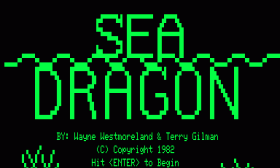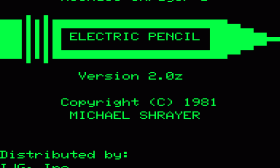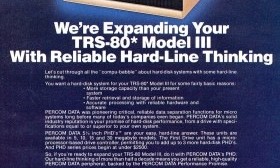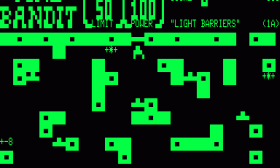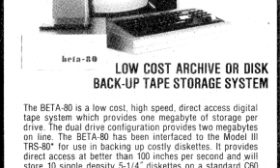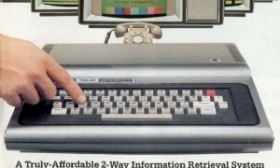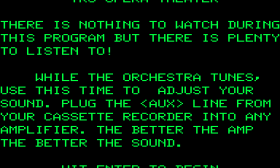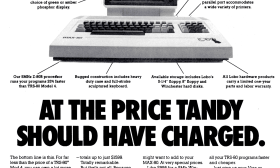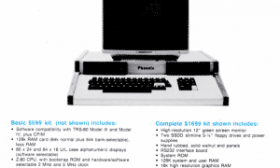Sea Dragon, written by Wayne Westmoreland and Terry Gilman, was one of the most popular games for the TRS-80. It was released in 1982 by Adventure International, which also sold versions for other computers:
- the Apple II version, written by John Anderson, was released in 1982.
- the Atari 400/800 version, written by Russ Wetmore (Star Systems Software), was released in 1982.
- the TRS-80 Color Computer version, written by Jim Hurd (Coniah Software), was released in 1983.
- the IBM PC version, written by Dan Rollins, was released in 1983.
- the Commodore 64 version, written by David H. Simmons, was released in 1984.
Along with Time Bandit and Arex, Sea Dragon was the TRS-80 game that was adapted to the greatest number of computers.
(Read more...)
Electric Pencil (also known as The Electric Pencil) was the first word processor written for a microcomputer. The original version was created by Michael Shrayer and released for the MITS Altair in December 1976. The TRS-80 version was released almost two years later and it dominated the market until the introduction of Scripsit.
Electric Pencil was one of only five pieces of software inducted into the 80 Micro Hall of Fame in 1983, with the panel stating that Electric Pencil “demonstrated conclusively that a TRS-80 could be used for serious word processing, and was the model for later word processors.”
(Read more...)
The Percom PHD was a line of 5 1/4" Winchester hard drives sold by Percom Data for the TRS-80 Model III, as well as several other computers. Introduced by Percom in 1982, the PHD used what was described as a “smart microprocessor-based drive controller” to allow up to four PHD drives to be connected to the Model III at one time. The Model III version also worked with the Model 4, but Percom never sold a version for the Model I.
The PHD drives were available in 5, 10, 15, and 30 megabyte sizes. The model numbers corresponded to the drive capacity: the PHD-10 was a ten megabyte drive. The prices started at $2,495.00 and increased with drive size.
(Read more...)
Time Bandit, written by Bill Dunlevy and Harry Lafnear, was a TRS-80 Model I/III game first released by Computer Shack in 1983. Computer Shack (which changed its name to Michtron in 1984) also released versions of Time Bandit for a number of other computers:
- the TRS-80 Color Computer (also released in 1983)
- the Sanyo MBC-550 (released in 1984)
- the Atari ST (released in 1986)
- the Amiga (released in 1988)
- the IBM PC (released in 1988)
The Atari ST and Amiga versions in particular remain quite highly regarded today.
(Read more...)
The BETA-80 was an “intelligent” cassette tape system that could store up to one megabyte on a single digital tape cassette. It was sold by MECA as an alternative to an Expansion Interface and disk drives. MECA sold versions of their digital tape systems for a number of computers using different names:
- BETA-80 for the TRS-80 Model I (and later the Model III)
- TAPE-II for the Apple II
- BETA-EX for the Exidy Sorcerer
- ALPHA-1 for S-100 computers
(Read more...)
In the early 1980’s, many people thought that interactive computer services over the telephone would be the “next big thing.” TRS-80 VIDEOTEX was Radio Shack’s solution for accessing centralized information services such as CompuServe, The Source, the Dow Jones Information Service, or custom VIDEOTEX services. It was described as “two-way information retrieval system for home or office use.”
Here’s a description of TRS-80 VIDEOTEX from a 1981 Radio Shack catalog:
(Read more...)
TRS-Opera, written by Richard Taylor, was an early TRS-80 music program. It was distributed by Acorn Software and sold for $9.95.
TRS-Opera is a BASIC program with an embedded machine language sound routine. The sound routine plays notes through the TRS-80 cassette port very rapidly, simulating more than one note at a time. The “opera” part of the name derives from the choice of music included with the program:
(Read more...)
The Lobo MAX-80 was a TRS-80 compatible computer sold by Lobo Systems (originally known as Lobo Drives International). Introduced at the 1982 National Computer Conference (where one could be reserved for a $100.00 deposit), the MAX-80 offered an impressive array of features including:
- a Z80B running at 5.07 MHz (making it one of the fastest microcomputers at the time)
- 64K of memory standard, with sockets for an additional 64K
- a double-density floppy disk controller with support for both 5 1/4" and 8" drives
- a hard disk controller interface
- video support through a standard RCA phono jack
- a screen size of 64 by 16 or 80 by 24 with a partially redefinable character set
- a TRS-80 style keyboard with CONTROL and ESCAPE keys, as well as F1 through F4
- one parallel port
- two serial ports
- real time clock with battery backup
(Read more...)
One of the more intriguing TRS-80 clones was the Phoenix, first advertised by Progressive Electronics in the August 1983 issue of 80 Micro. Designed by Keith Helwig, one of the proprietors of Progressive Electronics, the Phoenix was manufactured and sold in Lancaster, Ohio.
The Phoenix was offered in two configurations. The first was the “Basic kit” which cost $599.00 and included:
(Read more...)
In 1982, CompuServe changed their menu structure to “promote ease of use.” The new menus were grouped under six categories:
- Newspapers
- Home Services
- Business and Financial Services
- Personal Computing Services
- User Information
- Index
Any user could go directly to a page by using the “Go” command. For example, typing “Go HOM-1” would go to the “Home Services” menu page.
(Read more...)
